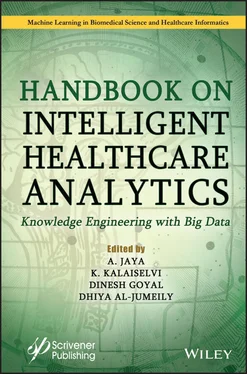Handbook on Intelligent Healthcare Analytics
Здесь есть возможность читать онлайн «Handbook on Intelligent Healthcare Analytics» — ознакомительный отрывок электронной книги совершенно бесплатно, а после прочтения отрывка купить полную версию. В некоторых случаях можно слушать аудио, скачать через торрент в формате fb2 и присутствует краткое содержание. Жанр: unrecognised, на английском языке. Описание произведения, (предисловие) а так же отзывы посетителей доступны на портале библиотеки ЛибКат.
- Название:Handbook on Intelligent Healthcare Analytics
- Автор:
- Жанр:
- Год:неизвестен
- ISBN:нет данных
- Рейтинг книги:4 / 5. Голосов: 1
-
Избранное:Добавить в избранное
- Отзывы:
-
Ваша оценка:
- 80
- 1
- 2
- 3
- 4
- 5
Handbook on Intelligent Healthcare Analytics: краткое содержание, описание и аннотация
Предлагаем к чтению аннотацию, описание, краткое содержание или предисловие (зависит от того, что написал сам автор книги «Handbook on Intelligent Healthcare Analytics»). Если вы не нашли необходимую информацию о книге — напишите в комментариях, мы постараемся отыскать её.
The book explores the various recent tools and techniques used for deriving knowledge from healthcare data analytics for researchers and practitioners. A Handbook on Intelligent Healthcare Analytics
Handbook on Intelligent Healthcare Analytics — читать онлайн ознакомительный отрывок
Ниже представлен текст книги, разбитый по страницам. Система сохранения места последней прочитанной страницы, позволяет с удобством читать онлайн бесплатно книгу «Handbook on Intelligent Healthcare Analytics», без необходимости каждый раз заново искать на чём Вы остановились. Поставьте закладку, и сможете в любой момент перейти на страницу, на которой закончили чтение.
Интервал:
Закладка:
KBE generative models can be a secret in producing MDO systems that are not multidisciplinary in return for adherence to science and that can handle complex problems reflecting actual industrial circumstances. We discuss the different models of current MDO systems and compare them to advanced KBE implementations in the next section to clarify this claim.
The third set of MDO structure implementation is available to overcome the weaknesses of the two approaches described earlier in this section by introducing generative models into the system. One advantage of this approach is that the exact geometry representations normally used for the use of high faithfulness analysis instruments may serve as a basis for the disciplinary study. It is therefore well adapted to the geometric nuances that are not included in a few general criteria of modern products. This geometry depiction is generated following individual tools of multidisciplinary system analyzers (BB SA) along with others, usually not schematic, product abstractions, and are systematically updated after each optimization loop. These MDO systems can fully resolve multidisciplinary cases without penalizing the degree of faithfulness and can contribute to the early stages of the design phase by addressing substantial changes in the shape and topology. They may also support a more sophisticated modeling method in which complex and accurate geometric models for high fidelity analysis are needed. These functions allow the early use of highly reliable testing approaches to be implemented with novel prototypes that do not have correct or unavailable semi-empirical and predictive technologies. The product modeling scheme which is the key feature of the MDO system is undermined by this approach.
1.5.3 CAD or KBE?
It is a mistake to know whether KBE is greater than CAD or vice versa. One is in the whole sense no bigger than the other, and we argue here that KBE should replace CAD. In certain circumstances, the KBE programming process is more suitable than the interactive application of the CAD platform, given that MDO supports one of the interests of this novel. This chapter is beyond the scope of a general debate about the suitability of one option for the next. The suggestions are as follows:
Where the focus is only on geometry development and manipulation; where considerations such as direct interaction with geometric models are important, graphical rendering and inspection are essential; if uniform, aesthetic, and heuristic design are the guides behind modeling, rather than engineering laws.
When it comes to design purposes, vocabulary is required instead of design results. The programming method of KBE systems offers the best solution in this case. Although CAD systems are committed to better documenting the results of the human design phase, KBE systems are designed to report the design procedure (i.e., the purpose of the design) and not just the results.
• A language is needed to promote automation while preserving continuity. Whenever the generative model is “played.” The same protocol (i.e., the same rules and logic processes are applied) is constantly repeated with different appropriate inputs regardless of which operator and of how many replays. In some engineering design cases, one of which is the optimization of design, an obstacle to automation is placed in the loop (except process supervision).
• A vocabulary offers a competitive advantage when it comes to the ease of interaction with external modeling and simulation applications. Usually, both CAD and KBE systems link (to each other and) through standard data interchange formats including IGES and Move. In times of ad hoc interchange files that are dependent on ASCIIs, the most useful approach to dedicated writers and parser production is full-function language programming. Also, the KBE system can detect and largely simplify these processes where the tool to be connected is required by complicated and knowledge-intensive pre-processing operations to schedule the input.
• Where there is an aesthetic facet of the architecture and details are produced, but at the same time an multidisciplinary research (MDA) and an optimization approach are used in the design and size of a given product, the best possible solution is provided by combined applications of CAD and KBE. In this case, the CAD process geometry would become the KBE application’s feedback. This implementation will support the complex MDA structure and return the material (partially or fully) to the CAD system, where comprehensive work can take place more immersive.
At the end of the day, the heuristic and non-respecting, geometric or non-repeatable, one-off, and repetitive aspects of the design phase coexist and are interlinked: Both CAD and KBE can contribute to this step, which must be the focus of both the creators of CADs and KBE’s smooth integration.
1.6 Guided Random Search and Network Techniques
There are some methods designed to find suitable designs using techniques that avoid the use of the pursuit of gradients or almost gradients. A system that either uses random variations in design variables or avoids direct variations in design variables by the use of learning networks supplements the use of directional searches. We have selected the genetic algorithm (GA) as a representative in the first category, RAT (GRS), and we have selected the Artificial NERN (ANN) as a regular illustration in the second category, network-based learning methods.
1.6.1 Guide Random Search Techniques
Without stringent enumeration, guide random search technique (GRST) methods are attempting to seek a whole feasible design field and, in principle, have a global optimum. If this optimum is not suitable internationally, then traditional exploration procedures provide no underlying means to move away from the optimal local field to continue the search for the optimum global setting. However, it should be borne in mind that there can be no confidence that a GRST algorithm can solve a complex design problem globally and, as mentioned elsewhere in the book, no answer can be challenged to ensure that a global solution has been discovered. The methods, though, are rigorous and usually will include a solution that significantly improves on any initial concept put forward by the design team.
GRST methods can deal with problems with the architecture of undistinguished functions and with many local improvements. The ability to deal with non-differentiable functions makes it easy to address problems related to distinct design variables, which are common aspects of structural design. Many GRST methods are well adapted for parallel processing, in particular the evolutionary algorithms mentioned in the next section. The number of implementing variables would allow concurrent processing to be used to respond within a reasonable period if every MDO problem is resolved by the GRST method rather than trivial.
Evolutionary algorithms are a subset of GRST techniques that employ very special approaches that focus on evolutionary concepts seen in nature. This approach also exposes some designs to spontaneous variations and offers anyone with a practical advantage an increased opportunity to produce “spring” designs. There are a number and different methods to solving complicated optimization problems using the same straightforward probabilistic technique. We are concerned with GA, which may be the most popular evolutionary form of algorithms in-process libraries or in commercial MDO systems.
1.7 Genetic Algorithms
GA is a family of computational methods based upon the evolutionary theory of Darwinian/Russel Wallace, used to solve general problems through optimization. Caution is in order at this point! The use of biology-inspired terms in the GA system demonstrates genetics, which engineers considered several years ago as an optimization process. Since then, substantial progress in biology has shown that true genetic growth is many compounders but only a convenient metaphor remains the term “genetics” used in this book. Instead of looking from one design point to another in search of improved design, the GA shifts to a second population with a reduced meaning for the restricted purpose feature, from an existing set of design points called group. A replication and mutation process on the computer model of the plant design points achieves progress from generation to generation.
Читать дальшеИнтервал:
Закладка:
Похожие книги на «Handbook on Intelligent Healthcare Analytics»
Представляем Вашему вниманию похожие книги на «Handbook on Intelligent Healthcare Analytics» списком для выбора. Мы отобрали схожую по названию и смыслу литературу в надежде предоставить читателям больше вариантов отыскать новые, интересные, ещё непрочитанные произведения.
Обсуждение, отзывы о книге «Handbook on Intelligent Healthcare Analytics» и просто собственные мнения читателей. Оставьте ваши комментарии, напишите, что Вы думаете о произведении, его смысле или главных героях. Укажите что конкретно понравилось, а что нет, и почему Вы так считаете.












